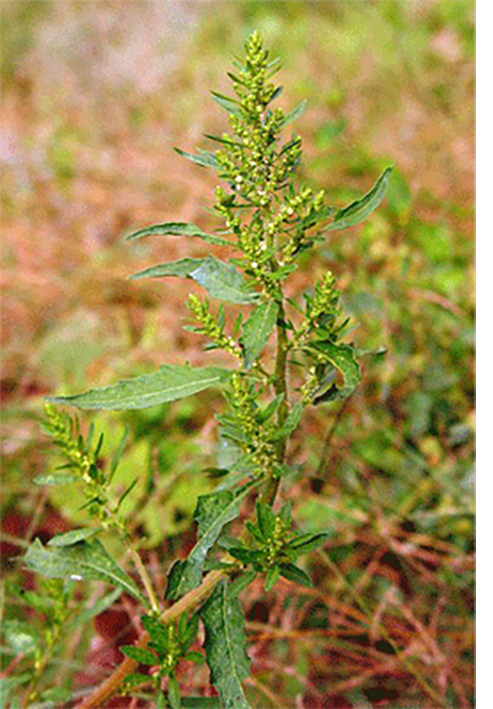 Epazote
Chenopodium
ambrosioides
whole plant and
flower spike..
Epazote
Chenopodium
ambrosioides
whole plant and
flower spike..
Welcome to the summary page for FabulousFusionFood's Herb guide to Epazote along with all the Epazote containing recipes presented on this site, with 6 recipes in total.
e This is a continuation of an entire series of pages that will, I hope, allow my visitors to better navigate this site. As well as displaying recipes by name, country and region of origin I am now planning a whole series of pages where recipes can be located by meal type and main ingredient. This page gives a listing of all the Cornish recipes added to this site.
These recipes, all contain Epazote as a major herb flavouring.
Epazote, Chenopodium ambrosioides (also known as Wormseed, Jesuit's Tea, Mexican Tea, Skunkweed, West Indian goosefoot, Jerusalem parsley, Hedge mustard, Sweet pigweed or Herba Sancti Mariæ) is an herbaceous plant of the Chenopodiaceae (chard/spinach) family. Epazote is native to Central America, South America, and southern Mexico and is closely-related to Fat Hen which it closely resembles. It is generally an annual (though it can develop as a short-lived perennial) that grows to 1.2m tall from which stalked, oblong-lanceolate leaves that can be up to 12cm long develop. The small green flowers are produced in a branched panicle at the apex of the stem. The name epazote comes from Nahuatl epazōtl by way of Spanish and it is now grown in temperate areas of Europe and the United States (Missouri, New England, Eastern United States).
The essential oil of the leaves is composed of various monoterpenoids (α-pinene, α-phellandrene, thymol, myrcene, p-cymene, terpinene, campher, trans-isocarveol) and ascaridole, a monoterpenoid peroxide.
The name epazote comes directly from the Náhuatl language, the language of the Aztec peoples of Mexico word epazōtl which is composed of the components epatl (skunk) and tzotl (sweat, dirt) referring to the often unpleasant aroma of the herb.
Epazote is mainly used as both a leaf vegetable and an herb. Raw it has a very resinous taste that is reminiscent of the liquorice flavour of anise, fennel, or even tarragon, but much stronger. The leaves have a very strong fragrance reminiscent of an intermingling of citrus fruit, savory, petrol and clay.
Traditionally it is used with black beans and is sometimes used to flavour other traditional Mexican dishes such as quesadillas, soups, mole de olla, tamales with cheese and chile, chilaquiles, eggs and potatoes, and enchiladas.
e This is a continuation of an entire series of pages that will, I hope, allow my visitors to better navigate this site. As well as displaying recipes by name, country and region of origin I am now planning a whole series of pages where recipes can be located by meal type and main ingredient. This page gives a listing of all the Cornish recipes added to this site.
These recipes, all contain Epazote as a major herb flavouring.
Epazote, Chenopodium ambrosioides (also known as Wormseed, Jesuit's Tea, Mexican Tea, Skunkweed, West Indian goosefoot, Jerusalem parsley, Hedge mustard, Sweet pigweed or Herba Sancti Mariæ) is an herbaceous plant of the Chenopodiaceae (chard/spinach) family. Epazote is native to Central America, South America, and southern Mexico and is closely-related to Fat Hen which it closely resembles. It is generally an annual (though it can develop as a short-lived perennial) that grows to 1.2m tall from which stalked, oblong-lanceolate leaves that can be up to 12cm long develop. The small green flowers are produced in a branched panicle at the apex of the stem. The name epazote comes from Nahuatl epazōtl by way of Spanish and it is now grown in temperate areas of Europe and the United States (Missouri, New England, Eastern United States).
The essential oil of the leaves is composed of various monoterpenoids (α-pinene, α-phellandrene, thymol, myrcene, p-cymene, terpinene, campher, trans-isocarveol) and ascaridole, a monoterpenoid peroxide.
The name epazote comes directly from the Náhuatl language, the language of the Aztec peoples of Mexico word epazōtl which is composed of the components epatl (skunk) and tzotl (sweat, dirt) referring to the often unpleasant aroma of the herb.
Epazote is mainly used as both a leaf vegetable and an herb. Raw it has a very resinous taste that is reminiscent of the liquorice flavour of anise, fennel, or even tarragon, but much stronger. The leaves have a very strong fragrance reminiscent of an intermingling of citrus fruit, savory, petrol and clay.
Traditionally it is used with black beans and is sometimes used to flavour other traditional Mexican dishes such as quesadillas, soups, mole de olla, tamales with cheese and chile, chilaquiles, eggs and potatoes, and enchiladas.
The alphabetical list of all Epazote recipes on this site follows, (limited to 100 recipes per page). There are 6 recipes in total:
Page 1 of 1
| Black Beans Origin: Mexico | Papadzules Origin: Mexico | Sopa Mexicana de Flor de Calabaza (Mexican Pumpkin Flower Soup) Origin: Mexico |
| Mole Verde (Green Mole) Origin: Mexico | Re-fried Beans II Origin: Mexico | Stewed Chayote with Tomato and Epazote Origin: Mexico |
Page 1 of 1